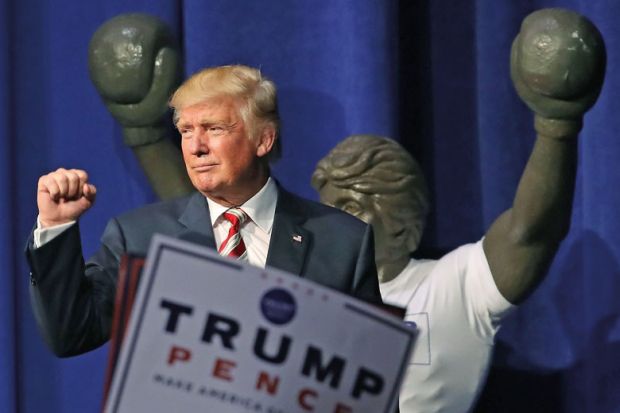“Trump stumbles on good idea.” That was the backhanded compliment in one headline after Donald Trump said he wanted to see universities spending their “tax-free” and “multibillion-dollar” endowments to lower tuition fees for students.
The comments, at a rally in Pennsylvania on 22 September, were the Republican presidential candidate’s first real statement on college affordability. By contrast, Democratic candidate Hillary Clinton – whom Mr Trump faced in the first presidential debate on 26 September – has made it one of her biggest policy priorities.
Mr Trump’s comments come at a time of growing concern across the political spectrum about how the wealthiest universities use their endowments. But when it comes to college affordability, has Ms Clinton left him in the shade on a vital issue with voters?
US universities lead the world in the size of their endowments, of course. Harvard University has the largest, with a value of $35.7 billion (£27.5 billion), followed by Yale University with $25.4 billion.
Mr Trump’s rally speech saw him accuse universities of failing to use their endowment income to benefit students. “Instead these universities use the money to pay their administrators, to put donors’ names on their buildings, or just store the money, keep it and invest it,” he said.
He also tried to signal an awareness of graduate debt: “The students are choking on those loans…And it’s something I hear more and more and it’s one of the things I hear more than anything else.”
“We have to deal with these universities”, he also said.
Mr Trump was echoing proposals from some Republicans in Congress, who have put forward a draft bill that would mean universities with endowments of over $1 billion would have to devote 25 per cent of annual endowment income for student financial aid or lose tax-exempt status.
Concern about the use of endowments is evident beyond the Republican Party.
The Education Trust, a non-profit advocacy group campaigning “for the high academic achievement of all students – particularly those of colour or living in poverty”, published a report on endowment spending in August this year.
Andrew Nichols, the group’s director of higher education research and data analytics, said: “As college continues to become more and more unaffordable for Americans, no group feels this burden like students from low-income families. If they choose to do so, institutions with extreme amounts of wealth can alleviate this burden today.
“In our study, we found that the 138 institutions with over $500 million in endowment assets were asking students from low-income families to pay – on average – nearly $13,000 each year to attend. This is unconscionable.
“As policy conversations on endowment spending go forward, it is critical that students from low-income backgrounds are kept front and centre.”
Reports on Mr Trump’s speech did not indicate that he made any specific mention of low-income students.
His endowment comments were seen as an attempt to reach out to the millennial voters courted by Ms Clinton with her college affordability plan, but in a way that would not involve any public spending.
Mr Trump had previously offered little on college affordability. However, some insight into Mr Trump’s potential higher education policies was offered earlier this year by the national co-chair and policy director of his campaign, Sam Clovis, who is an economics professor at Morningside College.
He indicated that the campaign was working on higher education plans including moving the federal government out of loan provision, with banks taking over and colleges taking a share of loan risk.
By contrast, Ms Clinton has given a high-profile pledge that would ultimately mean students from families with incomes up to $125,000 – around 80 per cent of US households – paying no tuition at public universities in their state.
Her aides have stated an estimated cost of $500 billion over 10 years, according to media reports.
Inside Higher Ed noted that not many institutions possess the “multibillion-dollar” endowments cited by Mr Trump, saying that presently about 50 colleges and universities came into that bracket.
That might raise questions about whether leveraging spending from large endowments would help enough students nationally.
Neil Gross, a professor of sociology at Colby College and author of Why Are Professors Liberal and Why Do Conservatives Care?, said Mr Trump’s idea “makes no sense and shows how out of touch with reality his campaign is”.
Noting the “tiny minority of US colleges and universities” with large endowments, he added: “Most of these wealthy schools already deeply discount tuition for students from disadvantaged backgrounds.
“It’s the under-resourced sector of American higher education that we need to beef up, and the only way to do that is with an infusion of public funds.”
POSTSCRIPT:
Print headline: ‘Students choking on loans’: Trump attacks colleges over endowments
Register to continue
Why register?
- Registration is free and only takes a moment
- Once registered, you can read 3 articles a month
- Sign up for our newsletter
Subscribe
Or subscribe for unlimited access to:
- Unlimited access to news, views, insights & reviews
- Digital editions
- Digital access to THE’s university and college rankings analysis
Already registered or a current subscriber?






